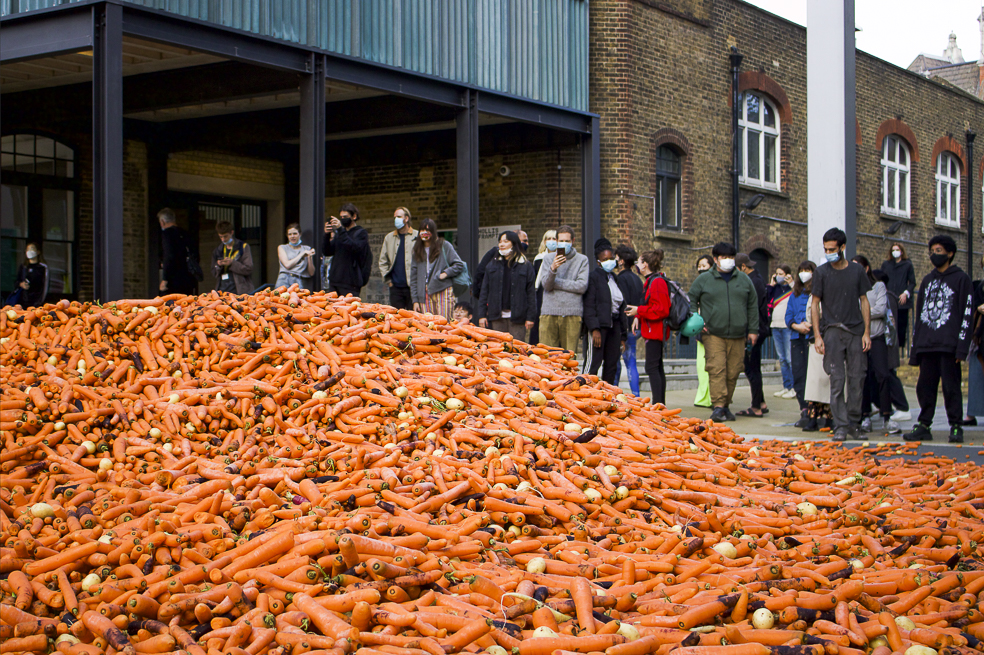On Wednesday, Sept. 30, a crowd of onlookers watched a truck dump nearly 30 tons of fresh carrots outside the Ben Pimlott building at Goldsmiths University in London. Initially mistaken for a prank or publicity stunt, the act was later revealed to be part of an art installation by Rafael Pérez Evans, an M.F.A. candidate at the art school. According to the artist’s website, in bringing together two disparate forms — the large contemporary glass university building and unwanted carrots — the tensions between urban and rural are brought to the forefront of viewers’ consciousness. “Grounding,” as the piece is titled, also refers to a form of protest historically used by European farmers who felt that their work was undervalued by governing powers.
Within a day after the initial dumping, the installation began to trend on Twitter, gaining over 67,000 likes following coverage of the event. With crowds lining up to take photos with the carrots, what qualifies “Grounding” as a work of art rather than an everyday social media spectacle? Aesthetically, “Grounding” seems to reflect the sentiments of several art movements, including Dadaism, Constructivism and Surrealism, that are collectively described as “anti-art.” Anti-art is exactly what it sounds like: art that challenges orthodox definitions of artistic expression. Pérez Evans evokes these ideas through his unusual choice of subject — unwanted, unfiltered, unassuming, unglorified — and yet the carrots are accepted and upheld as art. “Grounding” thus posits the question: Is overt amplification, in this case through sheer number, all it takes to create substantial “art” from prosaic possessions?
The story of Italian artist Maurizio Cattelan’s “Comedian” is similar. An ordinary object presented as a work of art is sensationalized, largely via internet memes and viral copycats, such that we suddenly consider the value of something so mundane as a banana. Cattelan, true comedian of the hour, ensures that the joke is clearly on us: a humble banana duct-taped to a wall is actually a gallery piece worth $120,000 that will soon be housed in the prestigious Guggenheim Museum. As with Pérez Evans’s piece, “Comedian” encourages us to once again consider the definition of art. Are we so engrossed in our own lives that we fail to see the artistic qualities of everyday things? How much of the world are we toning out? In an interview with Artspace, Cattelan himself concludes that “we are anesthetized.”
Paying proper attention to one’s surroundings is of little importance to most people, a notion that has persisted since the time of New York-based art critic Clement Greenberg. In his 1939 essay “Avant-Garde and Kitsch,” Greenberg explains that kitsch, or the “imitation of art” for the masses, is a product of American consumerism. We are too tired, too busy, to burden ourselves with artistic inquiry, and so we need art to be broken down, made accessible and presented to us as such before we even attempt to resonate with it — we need our carrots dumped before us en masse and our bananas plastered right in front of our faces. We want to experience “the staple of the culture” without putting in the work, making it far too easy to go on with our lives, unappreciative of the inspiration that surrounds.
Anti-art is reminiscent of Greenberg’s criticisms, satirically portraying the mundane as the sensational, the provocative, the worthy of attention. Like kitsch it allows us to be privy to the arrogance of being “cultured” — on the surface, praising a bunch of carrots for some deep message suggests a level of introspective enlightenment — but anti-art also mocks us, making us the final butt of its joke: art is everywhere around us and yet we are unable to recognize it. As Cattelan puts it, “reality is far more provocative than [his] art.”
Inevitably, we might arrive at the conclusion that the perceived monotony of life is nothing but an illusion of our own blinded constructs. The artist, in contrast, has freed himself of this humdrum reverie — and he has no qualms about displaying this in his work. In this way, a truckload of carrots or a banana duct-taped to a wall are a wake-up slap to the omnipresent intricacies of reality. We aspire to elevate above the commonplace, but it is by humble objects that we are ultimately grounded.
Contact Carissa Lee at carislee ‘at’ stanford.edu.
